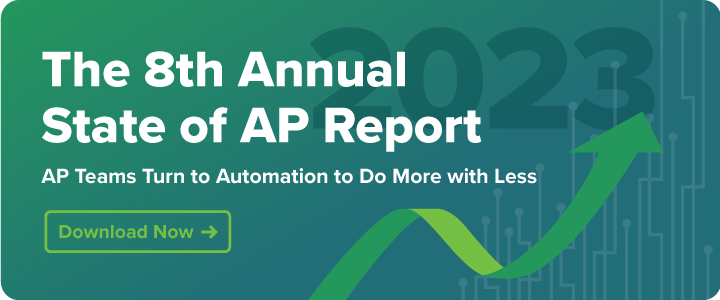What is Days Payable Outstanding (DPO)?
Days payable outstanding (DPO), or accounts payable days, is a ratio that measures the average number of days it takes for a business to pay its invoices. However, since invoice payments are often tied to cash flow, DPO can also be thought of as a measure of how long a business holds onto its cash assets.
DPO values vary across organizations, as there are benefits to both paying in a timely manner and advantages to extending out your business’ accounts payable days. An organization’s ideal DPO depends on many factors including company size and industry standards, as well as cash flow needs and business priorities. While DPO values are often specific to individual businesses, its general tracking as a finance metric is commonly used to make businesses more strategic and less reactive.
What is the Formula for DPO?
The formula for AP days, or DPO, is the following:
Accounts Payable x Number of Days ÷ Cost of Goods Sold (COGS) = DPO
DPO is just one of many metrics that AP departments may choose to track in order to optimize their cash flow and efficiency.
What Factors Affect DPO?
There are a number of factors that can affect days payable outstanding, including:
Company Size
Large companies usually take longer to pay their suppliers than small companies. This is because they have more power when negotiating with suppliers and can often get longer payment terms.
Type of Industry
Depending on the type of industry the company operates in can have a large impact on DPO. For example, the retail industry tends to have shorter DPOs than the manufacturing industry since they typically have a faster inventory turnover and need to pay their suppliers to keep their shelves stocked.
Credit Terms
The credit terms that a company negotiates with its suppliers can also have an impact on DPO. For example, if a business negotiates a 30-day payment term, its DPO will be shorter than if it negotiates a 60-day payment term.
Cash Flow
Businesses with a strong cash flow may be able to pay their suppliers faster than those that have a poor cash flow. Companies with tight cash flow may need to elongate their payments which can lead to a longer DPO.
Supplier Relationships
Having a positive relationship with suppliers can help your business negotiate more favorable payment terms.
Why Should Your Business Calculate DPO?
Businesses may choose to track DPO for several reasons. Below, we describe four of the most common reasons AP departments track this metric.
Improved Vendor Relationships
Vendor relationships have become more important for organizations looking to scale their services. In fact, 71% of companies noted that their supplier relationships became more strategic over the past year. This number is even higher for healthcare (75%).
It should come as no surprise that vendors like to get paid in a timely manner. By making a point of paying vendors on or before invoice due dates, your team can maintain a positive relationship that could prove essential for your business. In some cases, you may even need vendors to serve as a reference for a new supplier you are trying to bring on. Additionally, today’s strained supply chains make it harder for businesses to receive the materials they need. A low DPO can help ensure that vendors will prioritize your company’s orders, amidst a market with dwindling resources.
Early Payment Discounts
In some sectors, vendors may offer early pay discounts, reduced rates for customers who pay their invoices prior to the original due date. Depending upon invoice volume and the size of the discounts (often between 1% to 2%), paying early can yield its own effective income stream.
Optimized AP Workflow
Tracking DPO enables a better understanding of how well your AP workflow is operating. For example, it signals whether or not your organization is consistently paying vendors on time. This is critical, as overdue payments can lead to late fees and unhappy vendors, which is bad for business.
Cash Flow
Expenses in accounts payable has a direct impact on cash flow. A longer DPO means an organization has more cash on hand and can improve cash flow management. These metrics are often important for start-ups or companies looking to invest in something in the near-term.
How to Optimize Accounts Payable Days
Choosing to have a longer or shorter DPO should be a strategic decision. In essence, DPO is about balancing cash flow, payment discounts, and vendor relationships:
Longer DPO
A longer DPO leads to more cash flow. It means cash is in your corporate accounts for longer, which makes the list of assets on your balance sheets look more robust–a strategy that can help attract investors.
Shorter DPO
A shorter DPO leads to better vendor relationships. Depending upon the industry, you may share vendors with some of your competitors, which makes it even more essential to keep these relationships strong. Paying early may also allow you to capture early pay discounts, which saves your business money.
Often companies choose a mix of both approaches: shorter DPOs for important vendors and those that offer discounts, and longer DPOs for suppliers who either aren’t as strategically vital or are less impacted by later payments.
What Steps Should Businesses Take Looking to Either Shrink or Optimize Their Days Payable Outstanding?
Whether you’re trying to shrink your DPO or otherwise optimize it to balance cash flow and vendor relationships, consider switching to an AP automation solution. These solutions can significantly reduce the burden of manual tasks, streamline AP processes, and avoid errors and late payments. Additionally, your team will have more control and insight into when payment is actually executed.
MineralTree, for example, not only allows you to increase efficiency, but also completely control outgoing cash flow by setting instructions for exactly when and how to pay each vendor.
Case Studies of Companies Optimizing Their DPO
Here are just a few examples of businesses that are now reaping the benefits of optimizing their DPO by adopting MineralTree’s AP automation platform:
Forge Biologics Improves Vendor Relationships with AP Automation
A biotech company that focuses on gene therapy development, Forge Biologics recently experienced significant growth–going from 30 to over 300 employees in an 18-month period. This rapid growth left the company’s AP department struggling to keep up with vendor payments, which had a negative impact on vendor relationships. After adopting MineralTree, Forge Biologics was able to implement AP workflow automation, decreasing their DPO and improving supplier relationships.
House of Cheatham Takes a More Strategic Approach to AP
As one of the oldest continuing manufacturers of personal and beauty care products in America, House of Cheatham needed better financial controls to meet the high standards it set for its finance processes. Initially the company was very reactive with their invoices–paying each invoice the day it was received. There was no consideration about how to prioritize payments, or the potential benefits of holding onto cash, instead the team was solely focused on processing invoices to get them off their plate. After adopting MineralTree, the company gained visibility and control that put their finance team back in the driver’s seat. Now they can adjust their DPO to be more strategic instead of reactive, thus optimizing cash flow.
Final Thoughts: Using MineralTree for Better AP Analytics
When you automate AP processes, you digitize all invoice data in one place. This increases visibility into account balances and cash flow, and enables better decision-making around payment scheduling. AP automation vendors like MineralTree allow customers to use DPO more strategically, paying invoices earlier for important vendors or those that offer discounts, and paying other invoices later to optimize cash in hand.
MineralTree’s TotalAP is an end-to-end AP automation and payment optimization platform that includes AP analytics capabilities. Our analytics provide access to real-time dashboards that visualize KPIs such as invoice aging, payment mix, and rebates earned so that you can make more informed decisions. Learn more by requesting a demo today.
DPO Frequently Asked Questions
What is a Good DPO?
Simply put, there is no good or bad DPO, it’s all based on the size of the company, industry, payment terms, cash flow, and supplier relationship. For example, a high DPO means the company has more cash on hand, which can be beneficial for some organizations. However, it can also mean the accounts payable (AP) process is inefficient and vendor relationships may suffer. On the other hand, a short DPO could indicate an efficient AP process, but it could also mean that companies are leaving opportunities on the table. There is no ideal DPO; however, AP teams should strategically set their target DPO based on the company’s needs. Often, companies will have shorter DPOs with important vendors and longer payment terms with less important vendors.
How Can I Improve my DPO?
One of the most effective ways to improve DPO is to negotiate better payment terms with suppliers, automate invoice processing, and improve cash flow by increasing sales, reducing expenses, or improving your inventory management.
What are the Consequences of Having a High DPO?
Having a high DPO can result in damaged supplier relationships, late fees, reduced credit rating, cash flow problems, and in some cases, require legal action. That said, this is of course only true if the company has a high DPO because of an inefficient process. For companies lengthening their DPO from a strategic viewpoint, they will have more cash on hand, which can be an important initiative depending on the economy and goals of the company.
What is the Dfference Between DPO and Days Sales Outstanding (DSO)?
DPO measures the average amount of days it takes for a business to pay its suppliers while a DSO measures the average amount of days it takes for a business to collect payment from its customers for goods or services sold on credit.
Why is DPO an Important Metric to Track?
Tracking DPO provides insights into how long it takes your company to process invoices and render payments. It shows if you are consistently paying vendors late, early, or on time, which impacts your vendor relationships and organization’s cash flow.
How do AP Teams Use This Metric?
AP teams will use DPO differently. Some may track DPO with the goal of shortening it so that they can capture early payment discounts and promote strong vendor relationships. Others strategically optimize DPO so that they hold onto cash longer and only render payments on their due dates.
How Does DPO Impact Cash Flow?
Shorter DPO means you aren’t holding onto your cash, but also that you may be securing early payment discounts. Longer DPO can mean you end up paying late fees and compromising vendor relationships. Optimizing DPO is the balance of holding onto your cash as long as possible without negatively impacting vendor relationships or incurring penalties.
Is a Low DPO Good?
A low DPO is neither good nor bad. However, companies should be strategic when deciding to have a low or high DPO. Many companies opt to pay strategic vendors and suppliers earlier, while other organizations may opt for a higher DPO to improve cash flow.
What’s the Difference Between DPO and AP Turnover Ratio?
DPO measures the number of days companies take to pay their vendors. Accounts payable turnover ratio also helps finance teams evaluate how quickly suppliers are being paid, but the calculation and units of measurement are different. This formula generally showcases how often vendors are being paid in a given amount of time.




